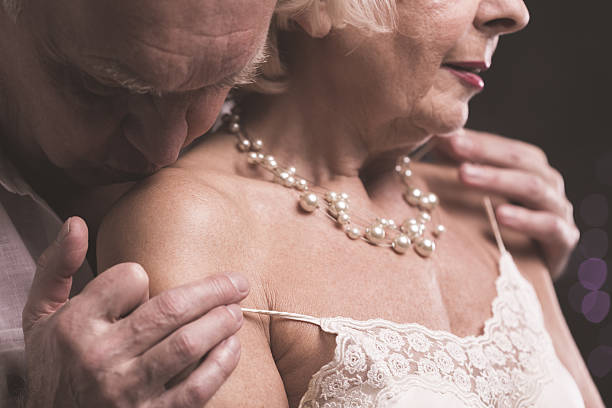Sexuality is touch, pleasure and contact with the body of the other. It is a universal need that strengthens the health and is a source of fulfillment and self-esteem.
We make a mistake thinking that it doesn't exist among the elderly. Nothing could be further from the truth. This view is a reflection of ageism (discrimination based on age).
At Chic chez vous, we promote an inclusive society that recognizes the needs of everyone, including the sexual needs and desires of seniors.
We therefore believe that sexuality among seniors should no longer be taboo and that we should talk openly about this subject in order to eliminate the stigma.
In this article, we will talk about our restrictive vision of sexuality among the elderly, the situation in CHSLDs, sexual diversity and sexually transmitted and blood infections (STBIs).
A restrictive and ageist vision
In 1970, Renée Claude sang " Le début d'un temps nouveau", a song about free love. It was the time of the sexual revolution where everything was allowed. How is it then that fifty years later, the sexuality of our elderly (the boomers) creates a discomfort ?

Even if the mentalities evolve a lot, many people in society perceive sexuality as having reproductive and performance goals. They associate sexuality with youth, beauty and health.
Elderly people are also associated with other clichés such as dependance to others, non-compliance with beauty standards and even perversion. There is a physical weakening that makes it difficult to find older people sexy. They move away from our image of what sexuality should be.
And furthermore, the elderly may internalize this ageism, that is, believe themselves that they are too old to have sexual experiences.
This restrictive view results that the elderly are under-represented in the media and also pornography. It's an age group that will be considered out of the norm. We are going to infantilize the elderly and see all sexual signs as ''cute'' or ''adorable'', without considering the erotic or sensual character.
The situation in CHSLDs
In the health care system, the professionals perceive the seniors through their disability and have difficulty to see them as gendered. In the CHSLDs in particular, the sexuality of the elderly is a subject that is highly taboo. The regular comings and goings of caregivers and shared rooms limit the possibilities of privacy for the elderly.
It would be more advantageous if the caregivers would be better trained on issues of sexuality among seniors. Unfortunately, they are often uncomfortable to deal with this issue with their patients because they imagine that seniors are uncomfortable talking about the subject. But, on the contrary, the elderly would like to be able to talk about it and that it would be the professionals who would address the subject.
We believe that the staff should be understanding and tolerant and avoid negative attitudes such as guilt, moralization or derision. The caregivers should learn to respect the privacy of the residents, such as knocking before entering a room.
We could also designate in CHSLDs or new seniors' houses, places ideal for sexual intimacy (privacy room), while ensuring that both residents are fully consenting. It is important to assess the consent in order to interpret the attitudes and actions of the residents, and to ensure that their choices are free and informed.
With regards to sexuality, we conclude that the CHSLD staff is often left to fend for themselves, with no guidelines to guide the intervention. That is why it is important to set up a reference framework, so that caregivers do not refer to their values, personal convictions or prejudices.
Families
The family also has a role to play. For some families, it is important to respect the needs and choices of their loved one, including when it comes to sexuality. Other families, much less comfortable, will ask for restrictions of contact between their loved one and the partner.
Therefore, between control and support, the answers to the sexual needs of CHSLD residents depend on the open-mindedness of families, staff and the institution.
Sexual diversity
On the other hand, we often have a cliché idea of sexuality among seniors, a classic commitment between a man and a woman, but there are also open unions and people who have multiple partners. It is true that some seniors are more in tenderness and sensuality, but others will like marginal practices, such as sadomasochism for example.
There is also the presence of sexual minorities (LGBTQ+) among the elderly population. For the LGBTQ+ seniors, disclosing their sexual orientation or gender identity can be challenging. Indeed, They lived at a time when homosexuality and transidentity were crimes punishable by imprisonment; a reality that is still relevant in many countries.

The LGBTQ+ seniors who disclose their sexual orientation or gender identity to those around them may experience relief from no longer having to hide and being able to truly show who they are. On the other hand, they risk experiencing more stigma.
Some LGBTQ+ seniors no longer have contact with their families because they do not accept their sexual orientation or their gender identity. For these people, their friends and romantic partners come to occupy such an important place in their lives, that they consider them their family.
The gay men's community
It also seems that ageism is extremely strong in the gay men's community (meaning that sexuality stops after a certain age). Some gay men will look for partners in exchange for money for fear of not finding a partner. In this context, these men can experience a lot of exclusion and isolation.

There are also gay men who live in CHSLDs that prefer ''stay in the closet'' because the staff is not trained to receive this type of testimony (even tough they were out of the closet when they were younger).
Sexually transmitted and blood infections (STBIs)
On another note, sexual health is often the last dimension that health professionals are concerned about in older adults. Because of taboos, the issue of sex is omitted by the doctors, hidden by the seniors leading to fewer tests.
Yet, sexually transmitted and blood infections (STBIs) have increased in the elderly in the past years. For example, cases of gonorrhea, syphilis, chlamydia and HIV are becoming more common among seniors. Apart from the question of taboos, what explains this increase ?

It seems that we see more and more seniors who have been in a long conjugal relationship, separate, have multiple sexual partners and become more at risk of contracting an STBI. They did not have the habit of using condoms in their youth. And since pregnancies don't concern them, they think condoms are no longer relevant to them.
Even though HIV cases are increasing in Quebec, it is clear that there is no HIV prevention campaign for seniors. It is therefore imperative to raise awareness in this regard.
Conclusion
In short, even if the mentalities are changing, we still have a restrictive and ageist view of sexuality among seniors. We believe that seniors are moving away from the image that we have of sexuality (youth, beauty, health). In the CHSLDs, sexuality of the elderly is even more taboo.
Sexuality among seniors, it's not only a classic commitment between a man and a woman. It is part of diversity. Open unions, multiple partners, marginal sexual practices, homosexuality, transidentity are also part of the rainbow.
I hope that this article has helped to go beyond the stigma surrounding sexuality among seniors.

Très intéressant et félicitations pour oser écrire un article sur un sujet très tabou encore de nos jours
Bravo Prunelle.
Avec intelligence et coeur, tu fais du bien à tes aïnéEs!